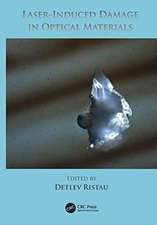Chiral Nanophotonics: Chiral Optical Properties of Plasmonic Systems: Springer Series in Optical Sciences, cartea 205
Autor Martin Schäferlingen Limba Engleză Hardback – 21 noi 2016
| Toate formatele și edițiile | Preț | Express |
|---|---|---|
| Paperback (1) | 775.46 lei 6-8 săpt. | |
| Springer International Publishing – 22 apr 2018 | 775.46 lei 6-8 săpt. | |
| Hardback (1) | 781.45 lei 6-8 săpt. | |
| Springer International Publishing – 21 noi 2016 | 781.45 lei 6-8 săpt. |
Din seria Springer Series in Optical Sciences
- 24%
 Preț: 945.45 lei
Preț: 945.45 lei - 18%
 Preț: 1850.21 lei
Preț: 1850.21 lei - 18%
 Preț: 2124.06 lei
Preț: 2124.06 lei - 20%
 Preț: 568.46 lei
Preț: 568.46 lei - 18%
 Preț: 1118.93 lei
Preț: 1118.93 lei - 18%
 Preț: 999.76 lei
Preț: 999.76 lei - 18%
 Preț: 957.62 lei
Preț: 957.62 lei - 18%
 Preț: 892.11 lei
Preț: 892.11 lei - 15%
 Preț: 648.56 lei
Preț: 648.56 lei - 18%
 Preț: 1838.07 lei
Preț: 1838.07 lei -
 Preț: 379.86 lei
Preț: 379.86 lei - 18%
 Preț: 1392.95 lei
Preț: 1392.95 lei - 18%
 Preț: 1232.89 lei
Preț: 1232.89 lei - 18%
 Preț: 1568.95 lei
Preț: 1568.95 lei - 18%
 Preț: 2095.49 lei
Preț: 2095.49 lei - 18%
 Preț: 1227.84 lei
Preț: 1227.84 lei - 15%
 Preț: 643.65 lei
Preț: 643.65 lei - 18%
 Preț: 954.45 lei
Preț: 954.45 lei - 18%
 Preț: 947.35 lei
Preț: 947.35 lei - 18%
 Preț: 1241.55 lei
Preț: 1241.55 lei - 18%
 Preț: 947.04 lei
Preț: 947.04 lei -
 Preț: 392.21 lei
Preț: 392.21 lei - 18%
 Preț: 997.53 lei
Preț: 997.53 lei - 18%
 Preț: 1562.31 lei
Preț: 1562.31 lei - 18%
 Preț: 1110.24 lei
Preț: 1110.24 lei - 15%
 Preț: 651.19 lei
Preț: 651.19 lei -
 Preț: 414.69 lei
Preț: 414.69 lei - 18%
 Preț: 952.57 lei
Preț: 952.57 lei - 15%
 Preț: 641.03 lei
Preț: 641.03 lei - 15%
 Preț: 635.80 lei
Preț: 635.80 lei
Preț: 781.45 lei
Preț vechi: 952.99 lei
-18% Nou
Puncte Express: 1172
Preț estimativ în valută:
149.53€ • 156.52$ • 124.46£
149.53€ • 156.52$ • 124.46£
Carte tipărită la comandă
Livrare economică 01-15 aprilie
Preluare comenzi: 021 569.72.76
Specificații
ISBN-13: 9783319422633
ISBN-10: 3319422634
Pagini: 75
Ilustrații: XV, 159 p. 79 illus., 75 illus. in color.
Dimensiuni: 155 x 235 x 11 mm
Greutate: 0.43 kg
Ediția:1st ed. 2017
Editura: Springer International Publishing
Colecția Springer
Seria Springer Series in Optical Sciences
Locul publicării:Cham, Switzerland
ISBN-10: 3319422634
Pagini: 75
Ilustrații: XV, 159 p. 79 illus., 75 illus. in color.
Dimensiuni: 155 x 235 x 11 mm
Greutate: 0.43 kg
Ediția:1st ed. 2017
Editura: Springer International Publishing
Colecția Springer
Seria Springer Series in Optical Sciences
Locul publicării:Cham, Switzerland
Cuprins
Introduction.- Chirality in Nature and Science.- Chiroptical Spectroscopy- Chiral Properties of Light.- Enhancement of Chiral Fields by Geometrically Chiral Structures.- Chiral Fields of Macroscopically Achiral Arrangements.- Formation of Chiral Fields Near Symmetric Structures.- Chiral Eigenmodes of Geometrically Chiral Structures.- Conclusions and Outlook.
Notă biografică
Martin Schäferling studied Physics and Computer Science in Münster. He was awarded for the best interdisciplinary diploma thesis in 2010. During his PhD in the group of Harald Giessen in Stuttgart, he investigated theoretical aspects of chiral plasmonics with a strong focus on tailored chiral near-fields. After he obtained his PhD in 2015, he joined the group of Thomas Weiss in Stuttgart, where he is currently working on advanced numerical and semi-analytical methods to study hybrid chiral plasmonic systems.
Textul de pe ultima copertă
This book describes the physics behind the optical properties of plasmonic nanostructures focusing on chiral aspects. It explains in detail how the geometry determines chiral near-fields and how to tailor their shape and strength. Electromagnetic fields with strong optical chirality interact strongly with chiral molecules and, therefore, can be used for enhancing the sensitivity of chiroptical spectroscopy techniques. Besides a short review of the latest results in the field of plasmonically enhanced enantiomer discrimination, this book introduces the concept of chiral plasmonic near-field sources for enhanced chiroptical spectroscopy. The discussion of the fundamental properties of these light sources provides the theoretical basis for further optimizations and is of interest for researchers at the intersection of nano-optics, plasmonics and stereochemistry.
Caracteristici
Leads to intuitive understanding of the difference between geometrical chirality and chiral responses Delivers a systematic study and comparison of different types of plasmonic nanostructures leads to a fundamental understanding of the chiral near-field response Shows theoretically how chiral near-fields can be used for enantiomer discrimination Includes supplementary material: sn.pub/extras

















